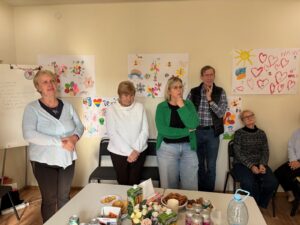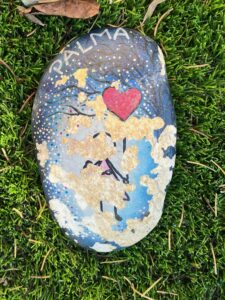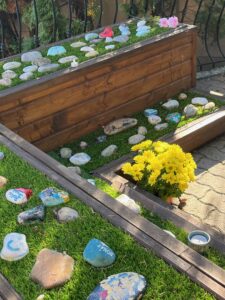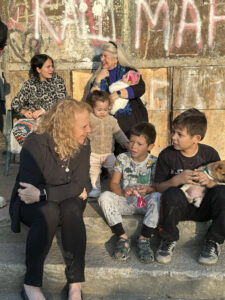
Memorials and Making a Life: Reflections from Ukraine and Hungary, November 2024
I have been asked several times to share some stories from my recent trip to the Ukraine and Hungary so the following are a few glimpses of what will take a lifetime to share.
The stones will serve as a reminder to you. In days to come, your children will ask you, ‘What do these stones mean?’ Tell them that the Lord cut off the flow of water in the Jordan River. Tell them its water stopped flowing when the ark of the covenant of the Lord went across. The stones will always remind the Israelites of what happened there.” Joshua 4:6-7
Berehove,Ukraine
In the center of the city square in Berehove, Ukraine sits a memorial erected to honor those who have lost their lives since the  invasion of Russian troops. As I read through the names and looked at the faces etched in stone, I tried to imagine the families, the friends and the dinner table chairs they left behind. I imagine my own beautiful adult children, the same age as many of those memorialized there, my heart feels tight while a lump in my throat forms, tears spill out. Honestly, I can’t imagine what it must be like for the mothers, the widows and the littles to endure the loss of their loved ones like this. The impact of war is much more brutal when it’s particular and personal. The emptiness weighs heavy, the silence screams “NO MORE! The idea behind so many of the memorials in places like Berehove is to “never forget.” That way the same thing will not happen again. Memorials act as a form of eternal vigilance.
invasion of Russian troops. As I read through the names and looked at the faces etched in stone, I tried to imagine the families, the friends and the dinner table chairs they left behind. I imagine my own beautiful adult children, the same age as many of those memorialized there, my heart feels tight while a lump in my throat forms, tears spill out. Honestly, I can’t imagine what it must be like for the mothers, the widows and the littles to endure the loss of their loved ones like this. The impact of war is much more brutal when it’s particular and personal. The emptiness weighs heavy, the silence screams “NO MORE! The idea behind so many of the memorials in places like Berehove is to “never forget.” That way the same thing will not happen again. Memorials act as a form of eternal vigilance.
There are days when I imagine my new friend,T working with Hungarian Baptist Aid, wishes she could forget. Forget the day she received the last call from her brother on the front when he said that he felt like he wasn’t coming home. Forget the day when she had to identify his body from the tattoo that was the only indicator left on his burnt remains. Forget the visceral rage and grief that accompanies her daily, while she reaches out to support displaced children and families with food, counseling and life affirming art and play. In the middle of her memories, she seems to cling to a larger hope. Hope that affirms that she is helping those still living, to survive and thrive. Hope that the roots of their resilience run deep and wide. Hope that helps her to show up and be present in the middle of, and because of her own loss.

I was privileged to create an artful space for reflection and remembering for our partners in Ukraine who are supporting their neighbors and those closely impacted by the war there. As I have shared before, God has allowed me the privilege of tending to the tenders. For a brief time, these beautiful souls who daily tend to others while carrying their own heavy loads, were able to let down, breathe, and be held in community. It was a sacred encounter that I will never forget.
Shoes on the Danube
In October of 1944, Hitler overthrew the leader of the Hungarian government, Miklos Horthy, and replaced him with Ferenc Szalasi. Szalasi, whose ideology closely followed Hitler’s, immediately established the Arrow Cross Party – a fascist, anti-semitic organization that brutally and publicly terrorized the Jews in Budapest by beating and killing them. In two years time, nearly 80,000 scapegoated Jews were expelled from Hungary in a death march to the Austrian border and approximately 20,000 Jews were brutally shot along the banks of the Danube River. The victims were forced to remove their shoes at gunpoint (shoes being a valuable commodity during World War II) and face their executioner before they were shot without mercy, falling over the edge to be washed away by the freezing waters. It is said that in order to save money on bullets, victims were tied together so that when one was shot and fell into the river, the other would also fall and drown alongside them.
 Shoes on the Danube Promenade is a haunting memorial tribute to this horrific time in history, created by film director Can Togay and the sculptor, Gyula Pauer. Installed along the bank of the Danube River in Budapest, the monument consists of 60 pairs of 1940s-style shoes, true to life in size and detail, sculpted out of iron.
Shoes on the Danube Promenade is a haunting memorial tribute to this horrific time in history, created by film director Can Togay and the sculptor, Gyula Pauer. Installed along the bank of the Danube River in Budapest, the monument consists of 60 pairs of 1940s-style shoes, true to life in size and detail, sculpted out of iron.
This memorial is simple yet chilling, depicting the shoes left behind by the thousands of Jews who were murdered by the Arrow Cross. The style of footwear – a man’s work boot; a business man’s loafer; a woman’s pair of heels; even the tiny shoes of a child – were chosen specifically to illustrate how no one, regardless of age, gender, or occupation was spared. Placed in a casual fashion, as if the people just stepped out of them, these little statues are a grim reminder of the souls who once occupied them – yet they also create a beautiful place of reflection and remembrance.
Tabitha’s House
Tabitha’s House is a one of its kind children’s hospice run by the Hungarian Baptist Aid organization. In this place of pea

ce and care, a team of nurses and counselors tend to children facing life-threatening disease and their families. Offering high quality medical support and respite services to families, Tabitha House serves a population often overlooked by others. In the courtyard of a lovely home in the suburbs outside of Budapest sits a little memorial garden filled with painted stones. Each stone represents a child who died at Tabitha House. Each stone was painted with images that filled the life of the little who lived there for a time. Smiling faces, balloons, hearts, flowers, trees, soccer balls and toy cars, all representing the beauty of the child remembered. This little stone garden, hidden away behind a wooden gate far from my home, touched me deeply, reminding me of my niece I lost 25 years ago.
nurses and counselors tend to children facing life-threatening disease and their families. Offering high quality medical support and respite services to families, Tabitha House serves a population often overlooked by others. In the courtyard of a lovely home in the suburbs outside of Budapest sits a little memorial garden filled with painted stones. Each stone represents a child who died at Tabitha House. Each stone was painted with images that filled the life of the little who lived there for a time. Smiling faces, balloons, hearts, flowers, trees, soccer balls and toy cars, all representing the beauty of the child remembered. This little stone garden, hidden away behind a wooden gate far from my home, touched me deeply, reminding me of my niece I lost 25 years ago.
Never forgotten, always as close as the stones along the way.
Making a Life

After working with our Ukrainian partners to pack 100 boxes of food to be distributed to needy families, we visited an abandoned building that was now home to a community of squatters. Of course I was drawn to the kids with a puppy. I was missing my own canine companion and got a little wet nose love and laughter on the steps as we waited for the food distribution to begin. I noticed the kind smile and steady gaze of the elder leaning on her cane while she waited in line for her box of food. I was compelled to help her carry it up to her room. After the slow climb up three flights of stairs, she invited me into her humble apartment. I noticed a neatly organized space, shelves full of books and knick knacks, a lovely crocheted bed covering, potted plants in the window, and a cat. Other than not speaking the same language, it was just like a visit with my auntie as she hugged me goodbye and smiled. With no conveniences like running water, electricity or garbage pickup, these
 families were somehow making a life. When I asked a young mother how long she had lived there, she told me this is where she grew up and doesn’t remember living anywhere else. In spite of the smell of rotting garbage upstairs, crumbling concrete in the hallways, and no light at night, life still happens. Babies are born and cared for, pets are cuddled, flowers are planted, beds are made, meals are prepared and eaten, and games like tag and soccer are played. Not that I would ever advocate substandard living conditions, it’s just that I noticed so many signs of life and normalcy in spite of the difficulties. There seems to be an indomitable spirit of beauty and connection that can’t be snuffed out of even and perhaps because of the harshest situations. I was reminded once again that our differences enrich us and proximity can change our perspective for the better.
families were somehow making a life. When I asked a young mother how long she had lived there, she told me this is where she grew up and doesn’t remember living anywhere else. In spite of the smell of rotting garbage upstairs, crumbling concrete in the hallways, and no light at night, life still happens. Babies are born and cared for, pets are cuddled, flowers are planted, beds are made, meals are prepared and eaten, and games like tag and soccer are played. Not that I would ever advocate substandard living conditions, it’s just that I noticed so many signs of life and normalcy in spite of the difficulties. There seems to be an indomitable spirit of beauty and connection that can’t be snuffed out of even and perhaps because of the harshest situations. I was reminded once again that our differences enrich us and proximity can change our perspective for the better.
Thanks for helping to make these encounters possible and for being a memorable part of the ongoing story of my life and ministry.
Remembering you always in my prayers,
Mylinda